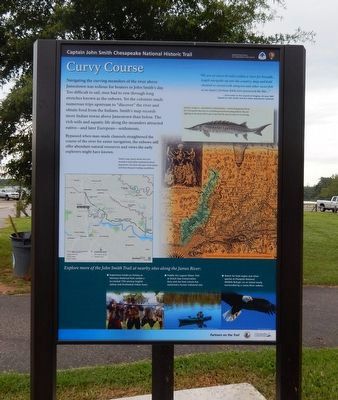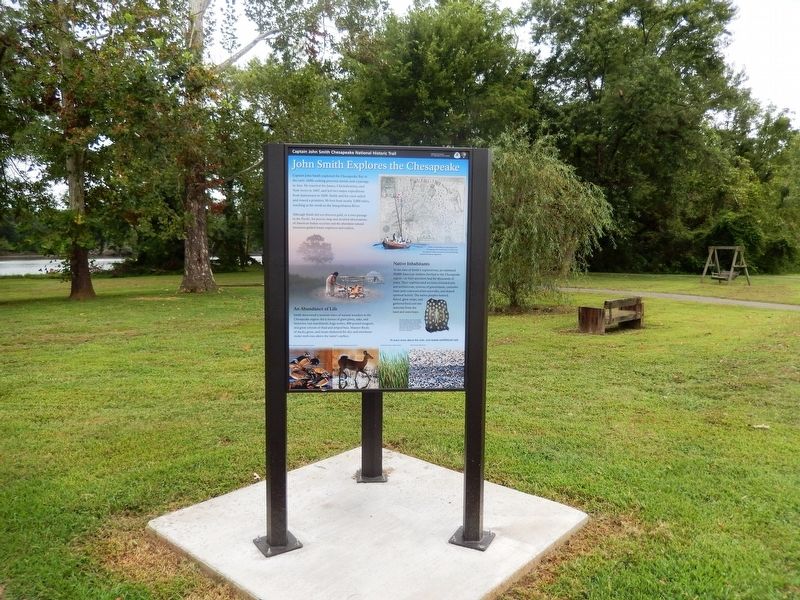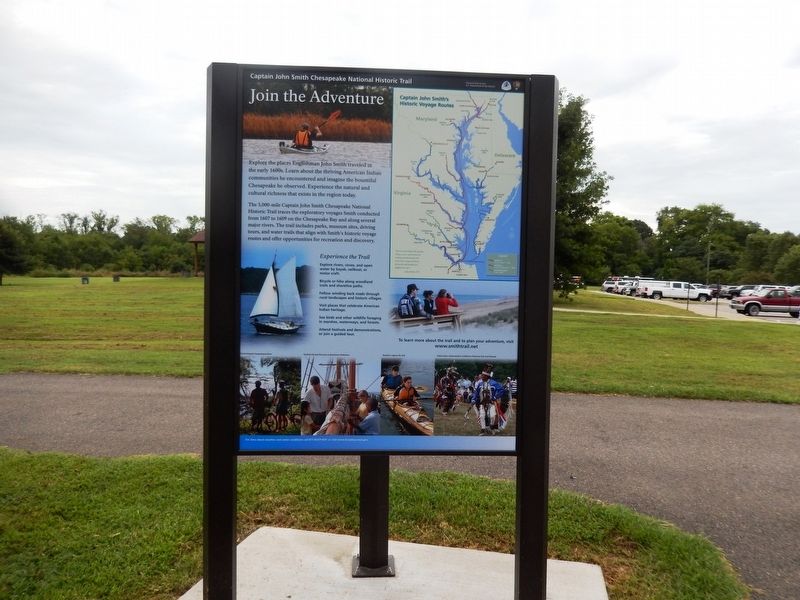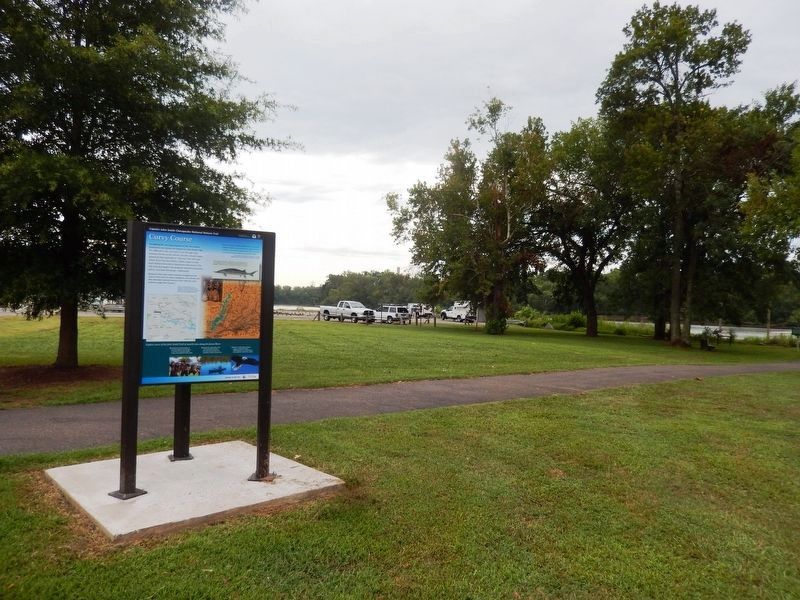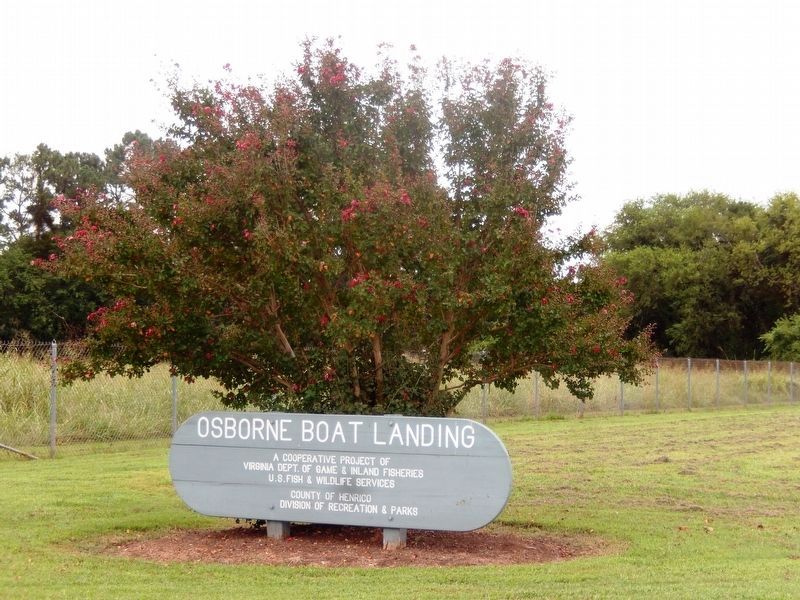Near Richmond in Henrico County, Virginia — The American South (Mid-Atlantic)
Curvy Course
Captain John Smith Chesapeake National Historic Trail
Curvy Course
Navigating the curving meanders of the river above Jamestown was tedious for boaters in John Smith’s day. Too difficult to sail, men had to row through long stretches known as the oxbows. Yet the colonists made numerous trips upstream to “discover” the river and obtain food from the Indians. Smith’s map records more Indian towns above Jamestown than below. The rich soils and aquatic life along the meanders attracted native—and later European—settlements.
Bypassed when man-made channels straightened the course of the river for easier navigation, the oxbows still offer abundant natural resources and views the early explorers might have known.
“We are set down 80 miles within a river for breadth…length navigable up into the country, deep and bold channel so stored with sturgeon and other sweet fish as no man’s fortune hath ever possessed the like…”
–First Letter to the Council of Virginia, 22 June 1607
Signed by John Smith and five other Jamestown colonists
(captions)
Smith’s map clearly shows the river meanders and Indian settlements above Jamestown. He knew this part of the James well from frequent trading expeditions.
Atlantic sturgeon—abundant in colonial times—nearly disappeared from the Chesapeake Bay due to overfishing and deteriorating Habitat. Recent sightings in the James River give hope that the species may be recovering.
Explore more of the John Smith Trail at nearby sites along the James River:
• Experience hands-on history at Henricus Historical Park midst a re-created 17th-century English colony and Arrohateck Indian town.
• Paddle the Lagoon Water Trail at Dutch Gap Conservation Area and see how nature has reclaimed a former industrial site.
• Watch for bald eagles and other species at Presquile National Wildlife Refuge, on an island nearby surrounded by a James River oxbow.
(panel 2)
John Smith Explores the Chesapeake
Captain John Smith explored the Chesapeake Bay in the early 1600s seeking precious metals and a passage to Asia. He traveled the James, Chickahominy, and York rivers in 1607, and led two major expeditions from Jamestown in 1608. Smith and his crew sailed and rowed a primitive 30-foot boat nearly 3,000 miles, reaching as far north as the Susquehanna River.
Although Smith did not discover gold, or a river to the Pacific, his precise map and detailed observations of American Indian societies and the abundant natural resources guided future explorers and settlers.
Native Inhabitants
At the time of Smith's explorations, an estimated 50,000 American Indians
dwelled in the Chesapeake region—as their ancestors had for thousands of years. Their sophisticated societies included arts and architecture, systems of government, extensive trade and communication networks, and shared spiritual beliefs. The native people hunted, fished, grew crops, and gathered food and raw materials from the land and waterways.
An Abundance of Life
Smith discovered a treasure trove of natural wonders in the Chesapeake region: thick forests of giant pines, oaks, and hickories; vast marshlands, huge turtles, 800-pound sturgeon, and great schools of shad and striped bass. Massive flocks of ducks, geese, and swans darkened the sky; and enormous oyster reefs rose above the water's surface.
To learn more about the trail visit www.smithtrail.net
(captions)
Smith’s remarkably accurate map of the Chesapeake Bay (published in 1612), and his spirited written accounts of a lush landscape inspired European migration.
Decorative shells-such as those found on this ceremonial robe-were valuable in the American Indian’s trading network that extended for hundreds of miles. This robe (which may have belonged to paramount chief Powhatan) was crafted from four elk skins and adorned with more than 17,000 shells.
Wood ducks and other waterfowl flourished
The forests and lowlands teemed with deer
Cattails grew thick in pristine marshes
Flocks of geese filled the sky
(panel 3)
Join the Adventure
Explore the places Englishman John Smith traveled in the early 1600s. Learn about the thriving American Indian communities he encountered and imagine the bountiful Chesapeake he observed. Experience the natural and cultural richness that exists in the region today.
The 3,000-mile Captain John Smith Chesapeake National Historic Trail traces the exploratory voyages Smith conducted from 1607 to 1609 on the Chesapeake Bay and along several major rivers. The trail includes parks, museum sites, driving tours, and water trails that align with Smith's historic voyage routes and offer opportunities for recreation and discovery.
Experience the Trail
• Explore rivers, coves, and open water by kayak, sailboat, or motor craft.
• Bicycle or hike along woodland trails and shoreline paths.
• Follow winding back roads through rural landscapes and historic villages.
• Visit places that celebrate American Indian heritage.
• See birds and other wildlife foraging in marshes, waterways, and forests.
• Attend festivals and demonstrations, or join a guided tour.
To learn more about the trail and to plan your adventure, visit
www.smithtrail.net
(captions)
Captain John Smith’s
Historic Voyage Routes
“Here are mountains, hils, plaines, valleys, rivers, and brookes all running most pleasantly into a faire Bay compassed but for the mouth with fruitful and delightsome land.”
– John Smith, 1612
Overlooking the Susquehanna River
Students aboard Discovery at Jamestown Settlement
Kayakers explore the trail
Indian dance demonstration at Jefferson Patterson Park and Museum
Erected by National Park Service, U.S. Department of the Interior.
Topics and series. This historical marker is listed in these topic lists: Colonial Era • Exploration • Native Americans • Settlements & Settlers • Waterways & Vessels. In addition, it is included in the Captain John Smith Chesapeake National Historic Trail series list. A significant historical date for this entry is June 22, 1607.
Location. 37° 24.1′ N, 77° 23.179′ W. Marker is near Richmond, Virginia, in Henrico County. Marker can be reached from Osborne Turnpike north of Kingsland Road, on the right when traveling south. The marker is located at the Osborne Boat Landing. Touch for map. Marker is at or near this postal address: 9530 Osborne Turnpike, Henrico VA 23231, United States of America. Touch for directions.
Other nearby markers. At least 8 other markers are within 2 miles of this marker, measured as the crow flies. Naval Assault at Drewry’s Bluff (within shouting distance of this marker); Osborne Landing (within shouting distance of this marker); a different marker also named Osborne Landing (within shouting distance of this marker); Fort Hoke: Empty Victory (approx. 1.1 miles away); Guns of Fort Brady (approx. 1½ miles away); Powder Magazine (approx. 1½ miles away); a different marker also named Powder Magazine (approx. 1½ miles away); Guarding the James (approx. 1½ miles away). Touch for a list and map of all markers in Richmond.
Also see . . . Captain John Smith Chesapeake National Historic Trail. National Park Service (Submitted on September 1, 2016.)
Credits. This page was last revised on July 7, 2021. It was originally submitted on August 31, 2016, by Don Morfe of Baltimore, Maryland. This page has been viewed 387 times since then and 24 times this year. Photos: 1, 2, 3, 4, 5. submitted on August 31, 2016, by Don Morfe of Baltimore, Maryland. • Bernard Fisher was the editor who published this page.
